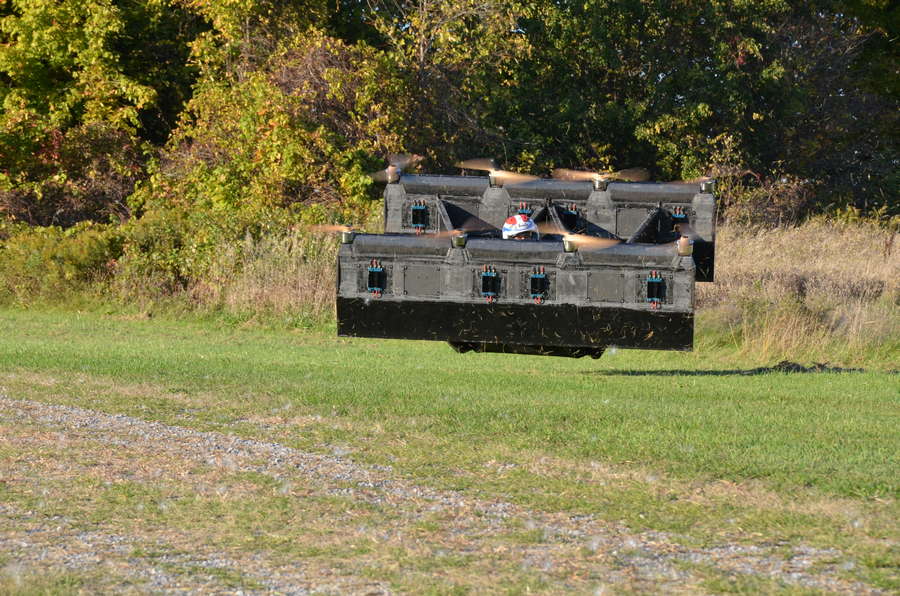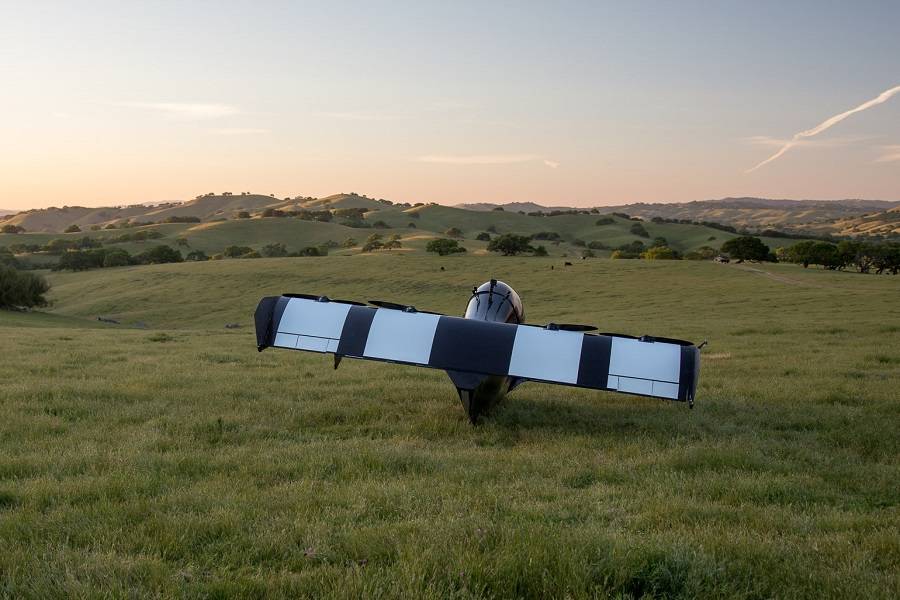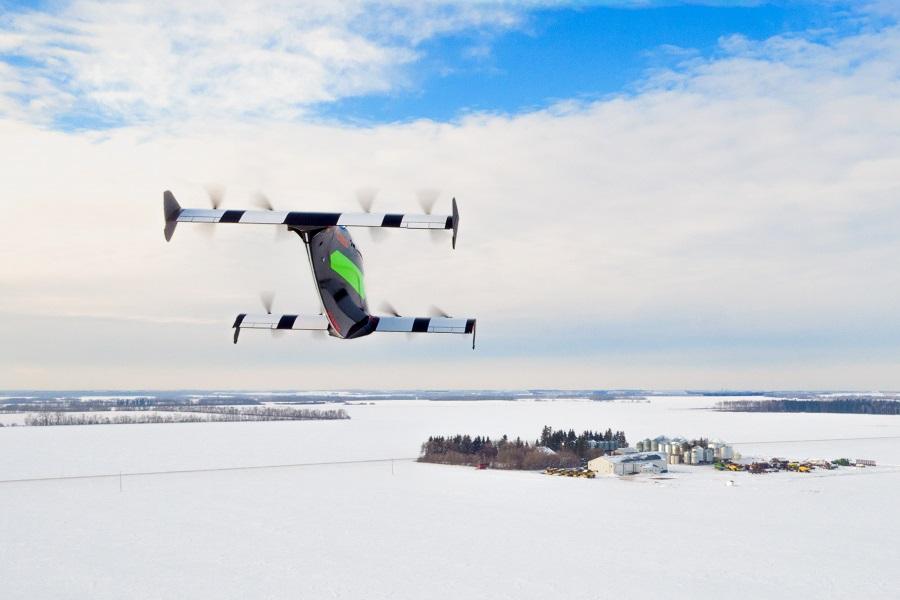We have covered several eVTOL designs here, but the Opener BlackFly seems different: simpler, easier to fly (and regulate)… and cheaper!
Opener launched the BlackFly concept several years ago. The first scale project flew back in 2014. The first version that could actually carry a person flew in February 2016 – finally flying with a person in March 2018. But actually, Marcus Leng, Opener CEO and Chairman, first flew himself in 2011, in a concept vehicle. It may have been a relatively short hover, but it certainly got the ball rolling.

The Opener BlackFly is an eight-rotor (octocopter, for those who insist) flying machine with a tandem wing design. The eight rotors and motors provide lift at take-off and landing, and forward thrust in cruise. The wings have “fault-tolerant”, redundant elevons, in pairs. The electric motors have ample excess thrust, to keep the vehicle flyable and stable, if a motor malfunctions. The entire setup uses redundant fly-by-wire. Finally, the BlackFly has a ballistic parachute system.
Since flying its second (first manned) BlackFly model in 2016, Opener has amassed over 4,000 flights. The first pre-production version flew in 2018, officially launching the program. The company boasts having done enough endurance flight cycles of the propulsion system, for an equivalent to 139 circumnavigations of the earth! That’s hard to fathom, but several test aircraft have flown a combined 39,000 miles (62,764km).

Flying the Opener BlackFly
Many operational features that Opener includes in their BlackFly, will be familiar to drone users. The vehicle has software flight-envelope protection, a Return-to-Home (RTH) button, and geofencing. The latter is handy, if you want to make sure you don’t enter the wrong airspace. Or if you don’t want to overfly something, perhaps. The pilot flies the BlackFly with two joysticks, which, again, is how we fly drones. Obviously, horizontal flight under wing(s), must pose more demands.
What Opener are doing with the BlackFly that makes it different, is that they’re going around two basic eVTOL problems. The simplest one, is its size. The nature of all-electric flying vehicles means that the higher the size/weight, the bigger the issues they have with energy capacity Vs weight. Sticking to a single-occupant design makes things simpler.

Having a single pilot/occupant also makes it possible for the Opener BlackFly to comply with Ultralight (Part 103) regulations in the United States. This means that pilots can fly it without a license (in uncontrolled airspace)! This could help immensely with market penetration, if the company later plans to introduce a bigger, sport-pilot (two-seat) version.
The other eVTOL issue that Opener’s BlackFly skirts cleverly, is the usual complexity of adding a wing to a multi-rotor design. Generally-speaking, vehicles that operate solely with lift rotors, aren’t very efficient. A winged design works better, but there’s a problem. One way to make such a design work, would be to have tilting motors, to switch between a hover and horizontal flight. Or, it would need separate motors for lift and horizontal thrust. Some designs use a mixture of both.

The Layout of the Opener BlackFly
The Opener BlackFly does neither of the above. It has fixed, non-tilting wings, with eight fixed motors and fixed-pitch propellers. It is quite hard to describe how this works, without linking to a video. Basically, the vehicle works by dramatically altering its pitch, between hover and horizontal flight. Thus, the orientation of the wings reflects the ‘cruise’ attitude of the aircraft (see below). A substantial amount of excess thrust seems to help, in both phases of the transition.
In terms of performance, that excess thrust means that the Opener BlackFly is quite impressive. US regulations for Ultralights pose certain limits, which don’t apply to some other countries. So, top speed is over 80mph (129km/h), but in the US it’s 62mph (100km/h). Battery capacity is limited to 8kWh in the US, capping range to 25 miles (40km). Elsewhere, the vehicle can have 12kWh, allowing for 40 miles (64km) of range.

Drawbacks? The radical changes in pitch/attitude that the design requires, make for some unusual ground handling. The Opener BlackFly has no wheels, but it can operate from grass, asphalt, snow and ice. However it comes with a vehicle cart, allowing single-person handling. Plus, the shape makes the BlackFly amphibious, a feature allowing much-needed extra weight in the Ultralight category. Also, the owner can quickly remove the wings, packing the BlackFly onto a trailer.
Different, But Simple
There are other, single-seat, all-electric, winged eVTOLs out there. But while they look more like the aircraft we know, they appear to be more complex than the Opener BlackFly. And unlike other projects we’ve seen, the company decided to devote time to ‘productionize’ its design, getting it ready for sales. The company already has stocks of wings, fuselages and other parts, and expects to start taking orders, soon.

Which, inevitably, brings us to the price. Sorry, we don’t have one. The only clue Opener gives us, is that the BlackFly will cost similarly to an SUV. But on the subject of money and funding, Opener has another unusual entry in its “About Us” page, setting it apart from other, flashier eVTOL projects: “Opener is well-funded and will not be seeking additional investors for the foreseeable future”.
We have looked at a lot of ambitious eVTOL projects here. The kind of projects that require investments from airlines, lessors and that launch IPOs. The way Opener seems to approach the market with BlackFly is different. An Ultralight (or Microlight, elsewhere) that faces less regulation, and needs less electrical energy! Picking EAA AirVenture 2021 for its first public display was certainly appropriate. It will be interesting to see it coming to market.




1 comment
William Jones-Halibut
It’s a billionaires toy and will never fly in controlled airspace because it hasn’t done the hard yards of a certification.. If you or I will ever fly eVTOL it will be something like Lilium jet